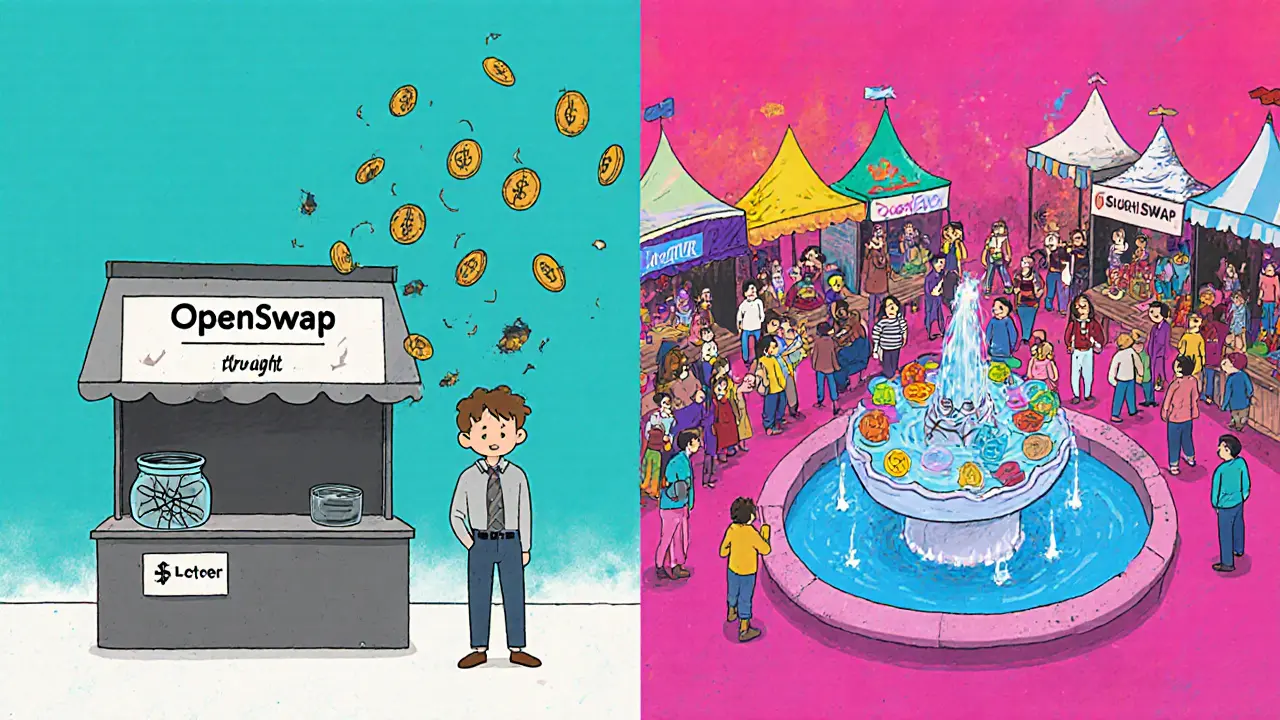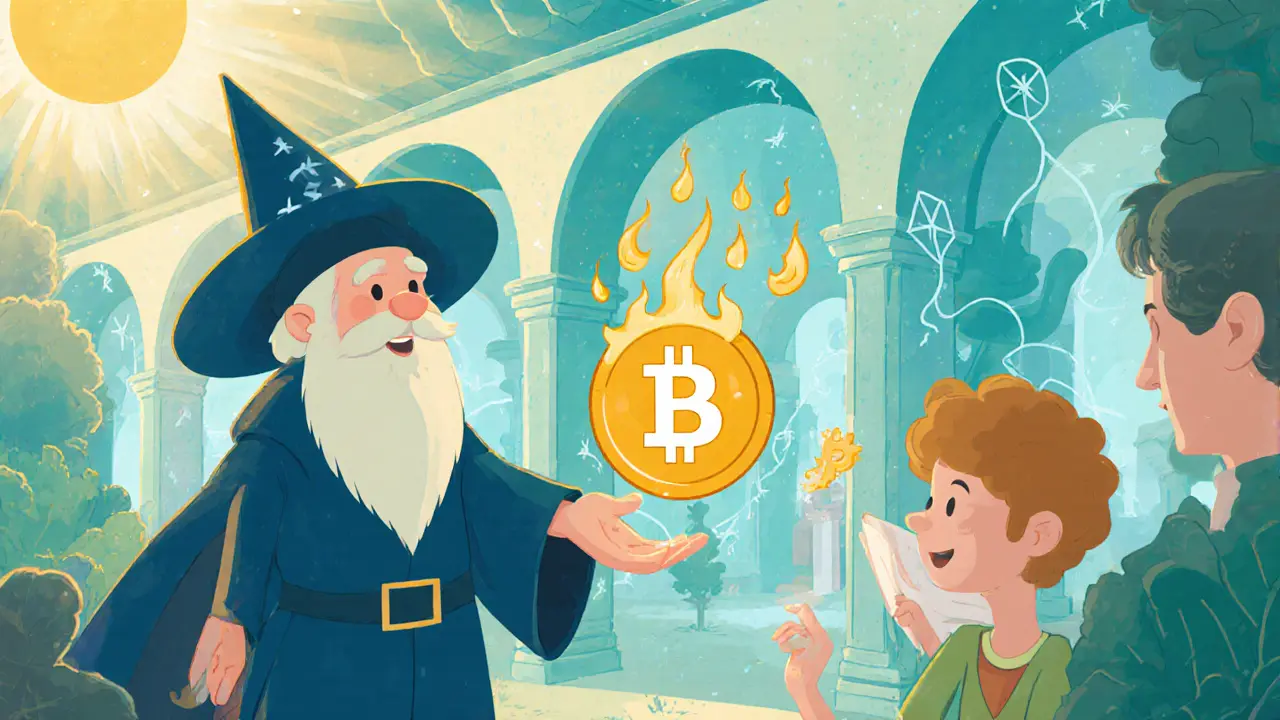OpenSwap OPS Token Burn Calculator
OpenSwap Tokenomics Overview
The OpenSwap DEX burns half of its trading fees (0.3%) to reduce the total supply of OPS tokens over time.
Estimated Annual Deflationary Effect
Enter values and click "Calculate Deflationary Impact" to see the estimated effect on OPS token supply.
Looking for a quick take on whether OpenSwap still matters in the DeFi world? This OpenSwap review cuts through the hype, tokenomics, and tech details so you can decide if the platform is worth a glance-or a skip.
What Is OpenSwap?
OpenSwap is a deflationary decentralized exchange built on the Harmony blockchain. Launched in May 2021, the platform markets itself as a "state‑of‑the‑art token‑burning DEX" that leverages Harmony’s sub‑second block times and ultra‑low fees.
The core idea is simple: every trade incurs a 0.3% fee, and half of that fee is permanently burned. By reducing the circulating supply of the native OPS token over time, the protocol hopes to create upward price pressure while rewarding early liquidity providers.
Tokenomics and Fee Structure
- Trading fee: 0.3% per swap (0.15% burned, 0.15% redistributed to LPs).
- Supply mechanics: Initial allocation of 13million OPS to liquidity miners, followed by a continuous mint of 1million OPS each month. No hard cap is set.
- Deflationary effect: Assuming average daily volume, the burn rate can offset a sizable portion of the monthly mint, but the exact net supply change varies with activity.
In theory, a shrinking supply combined with steady demand should boost token value. In practice, the burn mechanism also shrinks the incentive pool for market makers, which can hurt liquidity-a problem that has manifested on OpenSwap.
Liquidity, Volume, and Market Presence
Data aggregators list OpenSwap as an "untracked" exchange. That label means the platform does not meet minimum thresholds for publicly reported trading volume. As of October2025, the exchange shows no active pairs, no order‑book depth, and essentially zero daily volume.
Why so quiet?
- Liquidity providers earned a large initial OPS grant, but the ongoing monthly mint diluted rewards.
- Half‑of‑the‑fee burning removed part of the upside that LPs typically expect.
- Competing DEXs on Harmony-like SushiSwap, OpenOcean, and cross‑chain bridges-offer deeper pools and more active communities.
The end result is a classic chicken‑and‑egg scenario: low liquidity discourages traders, and low trading activity further depresses liquidity.
Technical Foundations
Harmony employs an Effective Proof‑of‑Stake (EPoS) consensus that finalizes blocks in roughly two seconds. Fees are touted as 100× cheaper than Ethereum, making the network attractive for high‑frequency swaps.
OpenSwap integrates standard Web3 libraries (ethers.js, web3.js), so wallets like MetaMask and Trust Wallet can connect with a single click. However, without active pairs, the wallet connection alone provides limited utility.

How OpenSwap Stacks Up Against Competitors
| Feature | OpenSwap | SushiSwap (Harmony) |
|---|---|---|
| Launch Year | 2021 | 2021 (expanded to Harmony) |
| Base Trading Fee | 0.3% (0.15% burned) | 0.3% (0.05% to protocol, rest to LPs) |
| Deflationary Mechanism | Half of fee permanently burned | None |
| Total Liquidity (approx.) | ~$0 (untracked) | >$15M+ (tracked on DEXTools) |
| Current Status | Inactive / untracked | Active, regularly updated |
| Wallet Support | MetaMask, Trust Wallet (works but no pairs) | MetaMask, Trust Wallet, Harmony native wallet |
The table makes it clear: OpenSwap’s unique burn model has not translated into real‑world liquidity, while SushiSwap leverages a more conventional fee split and enjoys a vibrant user base.
User Experience - What You’d Actually See
If you fire up the dApp URL today, the interface loads, lets you connect a wallet, and displays an empty “Markets” tab. Attempting to trade any token pair returns an error stating “No liquidity available.” There are no recent announcements, no roadmap updates, and the community channels (Telegram, Discord) show months‑old messages.
Contrast that with a functional DEX where you can instantly add liquidity, see live price charts, and view recent swaps. The lack of such basics on OpenSwap signals that the platform is effectively dormant.
Risks, Red Flags, and Outlook
- Liquidity risk: With almost no active pools, any attempt to trade would likely result in massive slippage or outright failure.
- Token dilution: The ongoing mint of 1million OPS per month can erode token value unless burning consistently outpaces minting.
- Community vacuum: No recent posts on Reddit, Telegram, or Discord mean no support network for troubleshooting.
- Regulatory shadow: As a DeFi protocol without a clear governance structure, future regulatory changes could freeze or limit its operations.
Given these factors, the realistic outlook for OpenSwap is bleak. Investors seeking exposure to Harmony’s DeFi growth would be better served by staking ONE directly, joining established liquidity farms on SushiSwap, or exploring emerging Layer‑2 solutions that have active developer backing.
Quick Checklist - Should You Use OpenSwap?
- Do you need a DEX with active trading pairs on Harmony? No.
- Are you attracted to token‑burn mechanics for speculation? Consider the dilution risk.
- Looking for community support and frequent updates? Look elsewhere.
- Need a wallet‑friendly interface? The UI works, but without markets it’s useless.
Bottom line: OpenSwap currently offers little practical value for traders, liquidity providers, or token investors.
Frequently Asked Questions
Is OpenSwap still operational?
As of October2025, the exchange shows no active trading pairs and is listed as “untracked” by major data aggregators. The UI loads, but users cannot execute swaps.
What is the purpose of the token‑burn mechanism?
Half of every 0.3% trading fee is sent to an irrecoverable address, reducing the OPS token supply. The idea is to create deflationary pressure that could increase token price over time.
How does OpenSwap compare to SushiSwap on Harmony?
SushiSwap maintains active liquidity, a regular update cycle, and no token‑burn fee. OpenSwap, by contrast, is largely inactive and relies on a deflationary fee that has not attracted sustained liquidity.
Can I still add liquidity to OpenSwap?
Technically you can approve tokens through the contract, but without any counterparties the pool will never be usable, and you risk impermanent loss with no ability to withdraw.
Is the OPS token listed on any major exchanges?
OPS is not listed on top‑tier centralized exchanges. It appears only on a handful of low‑volume DEX aggregators, and price data is sparse.


Comments
Natalie Rawley
Alright, let me break this down for everyone: OpenSwap’s burn‑and‑redistribute model looks slick on paper, but the reality is a ghost town. The UI loads, yet there are literally zero tradable pairs. You can’t even test a swap without hitting an error page. The tokenomics sound promising, but without liquidity the whole thing collapses. Bottom line – it’s a fancy brochure with no substance.
October 5, 2025 AT 09:23
John Corey Turner
Picture this: a DEX that promises deflationary pressure yet forgets the most vital ingredient – active markets. The 0.3% fee split, with half burned, is a clever economic experiment, but without a community of LPs it’s just dust in the wind. Harmony’s ecosystem is vibrant elsewhere, and OpenSwap feels like a missed opportunity. The architecture is sound, yet the execution is lagging far behind. If you’re hunting for real price discovery, you’ll have to look elsewhere.
October 18, 2025 AT 02:00